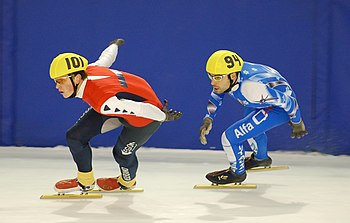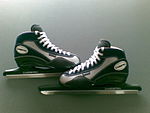Wikijunior:How Things Work/Ice Skates

Ice skates are boots with blades attached to the bottom. They are used in ice skating to propel oneself across ice surfaces.
Who invented it?
[edit | edit source]The oldest pair of skates known date back to about 3000 B.C., found in a lake in Switzerland. The skates were made from the leg bone of a horse, holes were bored at each end of the bone and leather straps were used to tie the skates to the feet.
The Dutch began using wooden skates with iron runners in the 14th century. They used poles with these skates to push themselves forward. Later, they added a narrow metal blade that allowed the skater to push off with his feet and still glide.
The steel ice skate was invented in 1867 by John Forbes, in Dartmouth, Nova Scotia.
Modern skating boots are usually rigid to support the foot and ankle. Traditionally, the boots are made of leather, but in recent years, boots made of synthetic materials have become more popular.
How does it work?
[edit | edit source]
Although ice is solid, as long as temperatures are above −20°C (−4°F) there is always a very thin layer of water on the surface that makes it slippery. Despite the cold, the ice melts because of the heavy weight of the skater pressing down on it. This slippery water lets the skater glide across the ice with little effort.
The blade on a modern ice skate has a double edge with a concave hollow between them. The two edges allow for a better grasp of the ice, even when tilted. Because the bottom of the blade is slightly curved, as the blade tilts to one side or the other, the edge which is in contact with the ice also curves. This causes the skater to turn. If the skates tilt to the right, the skater turns right, if the skates tilt to the left, the skater turns left.
How dangerous is it?
[edit | edit source]As with all sports, there are risks with skating. Ligaments can be torn just through skating too hard and bones can be broken through falling. A person can get a nasty cut (which can be lethal if it ruptures or severs a major artery or vein) if they are skated over by another person on the rink. The easiest way to prevent these things are to skate carefully and wear proper protective equipment.
What does it do?
[edit | edit source]It allows a person to move adeptly across a sheet of ice. A skater can glide quickly and stop and start quickly because of the design of the blade. A person can also turn in a controlled way when on the ice. A fast skater can go much faster than a fast runner. World record times for speed skating are about twice as fast as world record times for running the same distance.
How does it vary?
[edit | edit source]Figure skates
[edit | edit source]
Figure skates are used in the sport of figure skating. They have curved blades with large, jagged toe picks on the front, which are used for jumping. Figure skating boots are typically made of several layers of leather and are very stiff to provide ankle support for jumps.
Hockey skates
[edit | edit source]
Hockey skates are used for playing the game of ice hockey. The boot is generally made of moulded plastic, leather (often synthetic), and ballistic nylon. The blade is curved at both ends.
Racing skates
[edit | edit source]
Racing skates, also known as speed skates, have long blades and are used for speed skating. A clap skate (or clapper skate) is a type of skate where the shoe is connected to the blade using a hinge.
Touring skates
[edit | edit source]
Touring skates (or Nordic skates) are long blades that can be attached to hiking or cross-country ski boots and are used for tour skating or long distance skating on natural ice.
What has the impact been on the world?
[edit | edit source]Skates provide mainly fun and entertainment in the winter time. There are a number of sports that are played on ice skates including ice hockey, speed skating, and figure skating. These are some of the most popular sports in the Winter Olympics.
What idea(s) and/or inventions had to be developed before it could be created?
[edit | edit source]In order to make skates with a metal blade, people first had to have the ability to smelt (purify) and work metals like iron. Rigid shoes also make for better skates.
